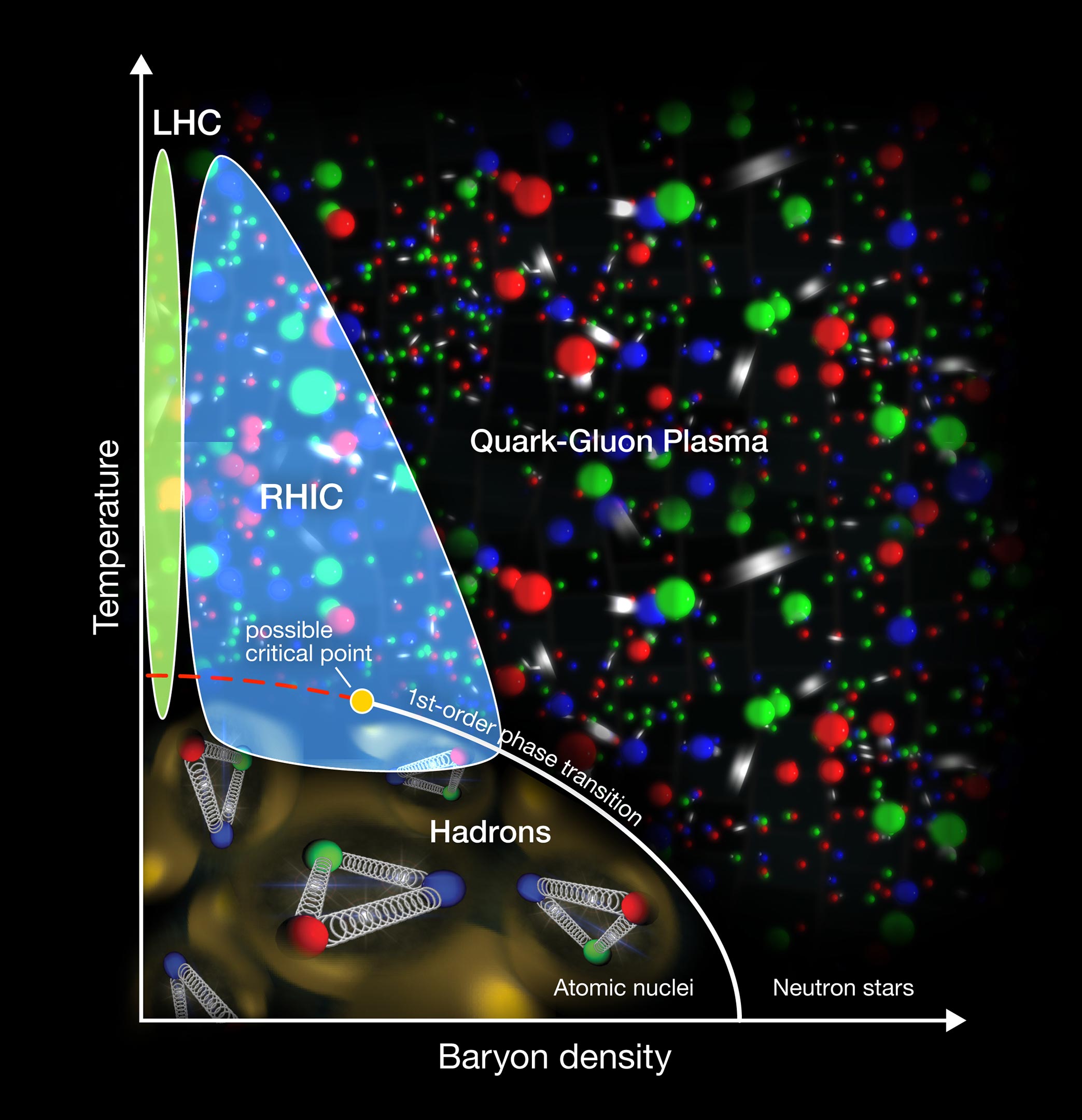بواسطة

مخطط طور مخمن للمادة النووية. ستساعد البيانات الجديدة – التي تُظهر طاقات تصادم عالية تنتج بلازما كوارك-غلوون (QGP) بينما لا تصادمات أقل طاقة – العلماء على رسم الحدود بين QGP ومرحلة هادرونيك. الائتمان: مختبر Brookhaven الوطني
من خلال تصادمات نوى الذهب عند طاقات متفاوتة ، وجد الفيزيائيون أن تكوين كوارك-غلوون[{” attribute=””>plasma—an exotic state of matter—halts at the lowest collision energy of 3 GeV. This discovery aids in mapping nuclear matter phases and identifying the conditions for QGP existence and its transition from ordinary matter.
The Science
Physicists can create an exotic state of matter known as a quark-gluon plasma (QGP) by colliding gold nuclei together. By systematically varying the amount of energy involved in the collision, scientists have shown that the QGP exists in collisions at energies from 200 billion electron volts (GeV) down at least to 19.6 GeV. However, its production appears to be “turned off” at the lowest collision energy, 3 GeV. The “off” signal shows up as a sign change—from negative to positive—in data that describe the distribution of protons produced in these collisions.
The Impact
The analysis compared the data with numerical simulations that include the formation of the QGP. If the data match the predictions, it provides evidence that a QGP has been formed. The sign switch at the lowest collision energy is therefore a sign that QGP formation is turned off at that energy. The findings will help physicists map out the phases of nuclear matter and the conditions of temperature and density under which QGP can exist, as well as the transitions between ordinary matter and QGP.
Summary
The new analysis used data collected by the Relativistic Heavy Ion Collider (RHIC) STAR detector during the first phase of the RHIC Beam Energy Scan to systematically search through 10 different collision energies. Scientists from the STAR Collaboration measured event-by-event the number of protons minus the number of antiprotons produced and a variety of characteristics of the distribution of the net-proton production. They compared their observations with “first-principles” calculations using the equations of quantum chromodynamics (QCD), the theory that describes the interactions of quarks and gluons. This approach, known as lattice QCD, simulates quark-gluon interactions on 4D space-time lattices.
At collision energies of 200, 62.4, 54.4, 39, 27, and 19.6 GeV, the data were consistent with a QGP. Below 19.6 GeV, the data continued to match the predictions, although with large error bars indicating the range of uncertainty. But at the lowest energy, 3 GeV, the scientists saw a dramatic shift. The order of the hierarchy among the analyzed characteristics flipped—and so did the sign of the key relationships, from negative to positive. This sign change is an indication, supported by these first-principles calculations, that the formation of QGP is turned off at RHIC’s lowest collision energy.
For more on this research, see When the Universe Changes Its Mind: Critical Point in Matter Transformation.
Reference: “Beam Energy Dependence of Triton Production and Yield Ratio (Nt×Np/N2d) in Au+Au Collisions at RHIC” by M. I. Abdulhamid et al. (STAR Collaboration), 16 May 2023, Physical Review Letters.
DOI: 10.1103/PhysRevLett.130.202301
This research was funded by the Department of Energy Office of Science, Nuclear Physics program, the National Science Foundation, and a range of international organizations and agencies listed in the related paper. The STAR team used computing resources at the Scientific Data and Computing Center at Brookhaven National Laboratory, the National Energy Research Scientific Computing Center (NERSC) at Lawrence Berkeley National Laboratory, and the Open Science Grid consortium.

“هواة الإنترنت المتواضعين بشكل يثير الغضب. مثيري الشغب فخور. عاشق الويب. رجل أعمال. محامي الموسيقى الحائز على جوائز.”





